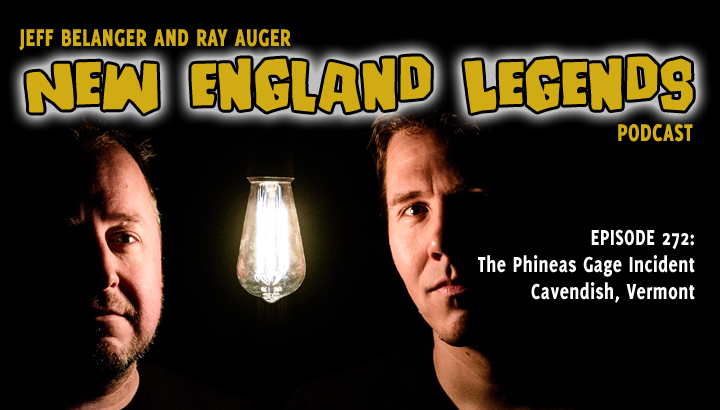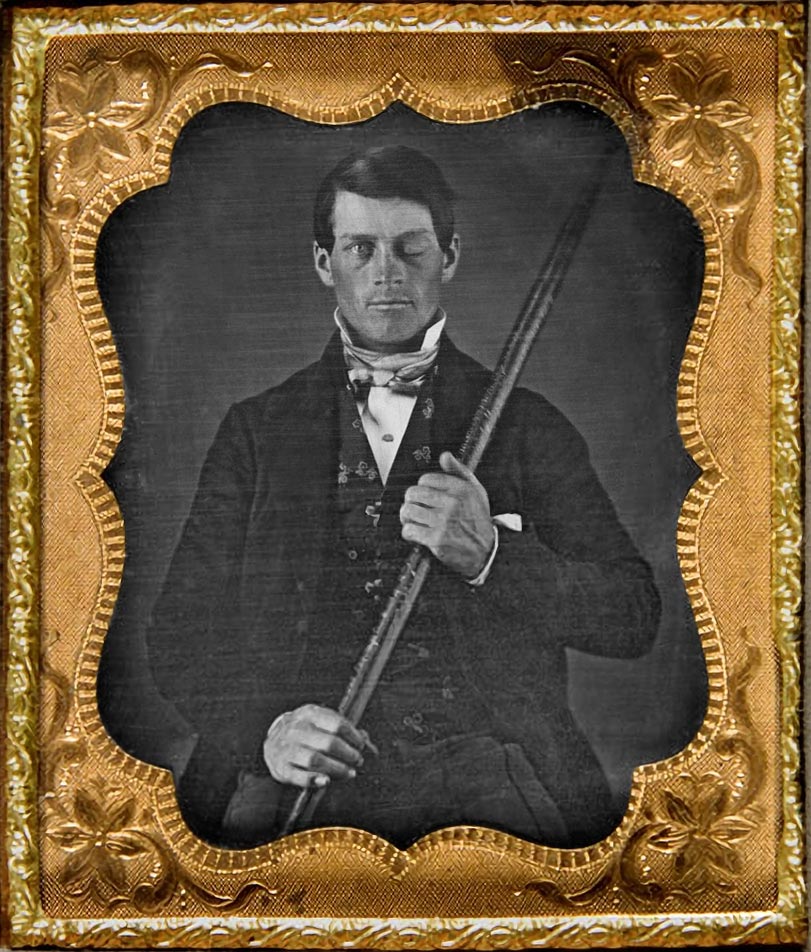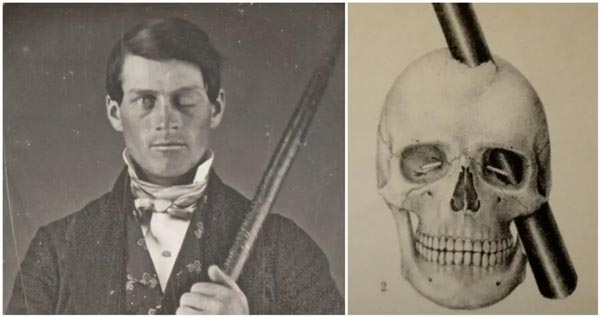

In Episode 272, Jeff Belanger and Ray Auger walk along the railroad tracks just south of Cavendish, Vermont, in search of the location of a horrible 1848 accident that launched an iron rod through the skull of railroad worker Phineas Gage. Gage became a medical miracle surviving the incident and becoming the subject of medical studies as well as a temporary living exhibit in P.T. Barnum’s American Museum. Today a monument in Cavendish commemorates the event and the doctor who saved Gage’s life.
BECOME A LEGENDARY LISTENER PATRON:
https://www.patreon.com/NewEnglandLegends
CREDITS:
Produced and hosted by: Jeff Belanger and Ray Auger
Edited by: Ray Auger
Guest Voice: John Bashford
Theme Music by: John Judd
SUBSCRIBE TO THE PODCAST FOR FREE:
Apple Podcasts/iTunes | Google Podcasts | Spotify | Pandora | Stitcher | Amazon Podcasts | TuneIn | iHeartRadio
JOIN OUR SUPER-SECRET:
New England Legends Facebook Group


EPISODE TRANSCRIPT:
*A note on the text: Please forgive punctuation, spelling, and grammar mistakes. Like us, the transcripts ain’t perfect.
[TRAIN WHISTLE]
[CHUGGING TRAIN PASSES]
RAY: Trains are amazing. They’re huge. They’re heavy. There’s still something romantic about them.
JEFF: I agree. There was a time when train tracks were just starting to interconnect this country and made us mobile like never before.
RAY: Is that why we’re walking along the railroad tracks here just south of Cavendish, Vermont, Jeff? We’re looking for a train?
JEFF: We’re exploring a really strange story this week, Ray. Not so much about a train, but about people who built the tracks.
RAY: I love it. Those unsung, working class heroes.
JEFF: This case is so strange, that I guarantee you’ve heard of it, even if you don’t recognize the name. And there’s even a monument in town that stands as a testament to this person considered a medical miracle. We’re in Cavendish, Vermont, exploring the Phineas Gage Incident.
[INTRO]
JEFF: Hello, I’m Jeff Belanger, and welcome to episode 272 of the New England Legends podcast.
RAY: And I’m Ray Auger, thanks for joining us on our mission to chronicle every legend in New England one story at a time. We’re glad you’re with us. Did you know many of our story leads come from you? This one did. Thanks to our photographer buddy Frank Grace for telling us about it. Frank, of course, produces the Haunted New England calendar with Jeff. I’ve got mine!
JEFF: You do! Now, before we explore the Phineas Gage Incident, we want to take just a minute to tell you about our sponsor, Nuwati Herbals!
RAY: Jeff, sometimes I feel like I’m juggling a hundred projects at once.
JEFF: I get it, Ray. You’ve got your daily radio show, your band, this podcast, your local band podcast, family, and everything else life throws at you.
RAY: So true. Which is why I’m sipping The Storyteller Tea from Nuwati Herbals.
JEFF: I’m right there with you, Ray. We’re all storytellers, whether we’re performing on stage, hosting a podcast, or getting through our regular work day. To tell the best stories, we need our memory and focus. The Storyteller Tea from Nuwati herbals is perfect for that.
RAY: The Story Teller Tea combines all-natural ingredients like green tea leaf, hawthorn flowers, oatstraw leaf, sage leaf, periwinkle flowers, lemon balm leaf, and other ingredients that frankly we can’t pronounce, to help keep your head focused and on-task.
JEFF: You wouldn’t want any accidents like poor Phineas Gage.
RAY: No.
JEFF: Let Nuwati Herbals help support your healthy lifestyle. Check out the Nuwati Herbals Web site to see all of their great products AND you get 20% off your order when you use the promo code LEGENDS20 at checkout. Visit Nuwati Herbals dot com. That’s N-U-W-A-T-I Herbals with an S dot com.
[WALKING IN GRAVEL]
RAY: It’s a pretty spot here along the train tracks just south of Cavendish, Vermont.
JEFF: It is. And our destination is just ahead where the tracks go through that rocky hill right there.
RAY: Okay, I have to admit, I’ve never heard of Phineas Gage, or his incident here in Cavendish, Vermont.
JEFF: I get it. I didn’t know his name either. But take a look at this picture.
RAY: Okay, I see a good-looking man wearing suit. His left eye is sewn shut, and he’s holding a large iron bar. Ohhhhh wait a minute. I DO know who this is. This is the guy who survived getting impaled on an iron bar.
JEFF: That’s him. A medical miracle. A sideshow attraction. And now a monument in the center of Cavendish, Vermont. To find out what happened, let’s head back to 1848 meet the man.
[TRANSITION]
[HAMMERS CLANKING ON ROCKS AND METAL SLOWLY FADING BEHIND]
RAY: It’s September of 1848, and America is growing fast on the back of the railroad. Tracks are being laid across the country making us interconnected like never before. Goods and people can travel hundreds of miles in a day. It’s an incredible time.
JEFF: There’s plenty of work available for able-bodied men, too. There’s tracks that need to be laid in every state and territory. Through mountains and valleys, connecting cities and towns.
RAY: Here in Cavendish, Vermont, there’s a crew hard at work laying tracks just south of town for the Rutland and Burlington Railroad. Phineas Gage is a foreman.
JEFF: Phineas Gage is 25 years old. He was born and raised in Grafton County, New Hampshire. He’s bright, strong, and innovative. He’s the foreman in charge of the blasting on this project. He’s been around explosives for most of his adult life. He even had a custom tamping iron made to use in setting explosive charges in rock.
RAY: It’s Wednesday, September 13th, about 4:30 in the afternoon, and Gage is setting an explosive charge into some rock.
[HAMMER ON ROCKS]
JEFF: A hole was just bored into the rock, so now Gage is filling that hole with black powder. (PAUSE) Now, he’s taking his tamping iron which is about three-and-a-half feet long, one-and-a-quarter inches in diameter, and weights just over 13 pounds, and he’s tamping down the powder to pack it in tight.
[THUMP THUMP THUMP]
Hey, Mr. Gage…
[METAL ON METAL]
[BOOM EXPLOSION]
JEFF/RAY: Oh no! Oh what just happened?!
RAY: This is terrible! The tamping iron just exploded out of the hole and launched right through Gage’s skull! The iron bar must have hit the rock and thrown a spark!
JEFF: He’s lying on the ground. Other workers are running over to see what happened. (BEAT) Ray, he’s got to be dead.
RAY: He must be. It’s too awful to watch. His skull is impaled on that iron tamping bar. It shot up through his left cheek and is sticking out through the top of his skull. He’s…. he’s bleeding pretty badly.
JEFF: Wait a minute… he’s still moving. He’s twitching like a convulsion. It’s awful! But wait… he’s reaching for the tamping bar in his skull! Phineas, just lie still! There’s been a terrible accident!
RAY: I… I can’t believe it. He’s sitting up with an iron bar sticking out of his skull! I think he’s trying to get up!
[HORSE WAGON]
JEFF: They’re bringing a wagon around to get Phineas some help. Though I can’t imagine anyone can help him now. If he so much as sneezes he’s a goner. Or he’s going to bleed out on the way back to town for sure.
[HORSE WAGON FADES]
[DOOR OPENS AND CLOSES]
RAY: This is incredible! Phineas is mostly walking on his own. There’s two men helping him, but Phineas is mostly under his own power. They’ve brought him back to his lodging house.
JEFF: I can’t watch this… Phineas is determined to pull the bar out of his skull…
JEFF/RAY: Ohhhh! I think I’m going to be sick.
JEFF: He’s still bleeding badly. They’ve already sent for the doctor.
[HORSE WAGON PULLS UP]
RAY: It’s about 5:00 PM when Dr. Edward Williams pulls up to the hotel where he finds Phineas Gage sitting in a chair outside the hotel waiting for him. Dr. Williams describes the scene.
DOC WILLIAMS: When I drove up he said, “Doctor, here is business enough for you.” I first noticed the wound upon the head before I alighted from my carriage, the pulsations of the brain being very distinct. The top of the head appeared somewhat like an inverted funnel, as if some wedge-shaped body had passed from below upward. Mr. Gage, during the time I was examining this wound, was relating the manner in which he was injured to the bystanders. I did not believe Mr. Gage’s statement at that time, but thought he was deceived. Mr. Gage persisted in saying that the bar went through his head. Mr. Gage got up and vomited; the effort of vomiting pressed out about half a teacupful of the brain through the exit hole at the top of the skull, which fell upon the floor.
JEFF: From what Phineas told bystanders, it sounds like he was distracted while he was tamping down the black powder for just a second, and must have sparked off a rock. It’s 6:00 o’clock when Dr. John Harlow arrives.
RAY: The two doctors perform surgery on Gage’s skull. They shave his head around the wound and clean it out as best they can. They manage to take some of his broken pieces of skull and place them back onto his head like puzzle pieces. After bandaging his head, there’s nothing more they can do. Now we wait.
JEFF: No one expects Gage to survive. But as each hour passes, he defies the odds. Still, his friends get to work.
[HAMMER AND NAILS AND SAW]
JEFF: They build his coffin. There’s no doubt he’s going to need it.
RAY: It’s September 25th. For the last 12 days, Phineas Gage has been in and out of a semi-comatose state. He can speak and kind of grunt when you ask him a question. But only a word or two. He’s lost a lot of blood, but he’s still alive. But now he’s got another problem.
JEFF: He does. Dr. Harlow observes an infected kind of fungus growing around Gage’s left eye and the wound on top of his head. It’s an abscess. Dr. Harlow removes the infection and applies crystalline silver nitrate to kill the infection.
RAY: It’s October 7th. 24 days since the accident. Everyone in Cavendish is shocked to find Phineas Gage up and walking around under his own power. He’s lost his infected eye, and he seems forgetful and frail, but it looks like he’s going to survive.
[HORSE AND WAGON]
JEFF: On November 25th, Phineas Gage returns to his parents’ home in Lebanon, New Hampshire. Throughout the coming winter, he’s getting stronger physically and mentally each day. Pretty soon, he’s helping out with chores. Feeding the cattle, and that kind of thing. His mother noticed that her son’s memory seems a little off, but maybe a stranger wouldn’t notice.
RAY: By the summer, Phineas Gage is mostly back to normal physically, though he complains that he feels strange sometimes. No pain in his head. He just feels off at times. Dr. Harlow, who knew Phineas before the accident, publishes a paper that though Gage had recovered physically, his personality had changed, implying that damage or changes to the physical brain, could alter a person’s behavior.
[CROWD OF PEOPLE TALKING AND MURMURING]
RAY: It’s November of 1849, just over a year since the accident. That’s when Henry Bigelow, Professor of Surgery at Harvard Medical School, brings Phineas Gage to Boston for a medical study. Everyone is curious as to how he survived, and how he can function so well given how much of his brain was damaged in the accident.
JEFF: Unable to return to his work on the railroad, Phineas Gage needs to earn money. So he becomes an attraction.
[OLD TIME CIRCUS MUSIC]
JEFF: Gage heads to New York City where he becomes a temporary living exhibit in P.T. Barnum’s American Museum.
RAY: The guy has to earn a living somehow. He figures there’s worse things to be known for than being a quote Wonder of the World. And that brings us back to today.
[TRANSITION]
JEFF: In 1852, Gage moved to Chile to work as a long distance stage coach driver. That life was difficult, and didn’t help his health. By 1859, Phineas Gage moved to San Francisco where his parents lived. He was frail, and his health was failing. Now prone to epileptic seizures, the convulsions happened more frequently until he died May 21st 1860. He was 36 years old.
RAY: This case made all the newspapers back in 1848. The brain was still a huge mystery back then.
JEFF: It still is today! I mean, we’ve come a long way since then, but we still don’t know enough about this most critical of organs.
RAY: Many medical journals wrote about the quote American Crowbar Case…
JEFF: Which of course is a misnomer. It was never a crowbar. It was an iron tamping rod.
RAY: No matter what you call it, the Phineas Gage Incident, got a lot of ink in medical journals. They all credited Dr. Harlow with saving Gage’s life. His surgery skills and treating the infection are what saved a man who would have died otherwise.
JEFF: We should point out that the story of Phineas Gage didn’t end with his burial. Around November of 1867, his body was exhumed and his skull was sent to Dr. Harlow. In 1898, Dr. Harlow donated the skull and tamping iron to Harvard where they still bring it out to display now and then. For the rest of the story, we’re going to head back into the town of Cavendish.
[WALKING ON GRAVEL FADES]
JEFF: We’re walking to the corner of High Street and Main Street in town. (PAUSE) And there’s the monument. Take a look Ray.
RAY: It’s a stone monument about waist-high with a plaque on it. The plaque says it was placed here on September 13, 1998—the 150-year anniversary of the accident. There’s a timeline on there, an embossed image of the skull with the tamping rod through it, and a paragraph about Dr. Harlow. It’s really a monument to Dr. Harlow, if you think about it. His image is also embossed on the plaque as well.
JEFF: There’s an old myth that we only use 10 percent of our brains.
RAY: Through impossible odds, that iron bar shot through the 90% Gage didn’t need.
JEFF: The 10% thing isn’t really true. MRI scans have shown various parts of our brain light up during different events. So it’s not like 90% of our brains are extraneous. But Phineas Gage was an early medical example of how resilient this vital organ can be. That it can suffer such trauma and still we can recover to the point of living a normal life again.
RAY: A normal life that was cut pretty short. Phineas Gage died at age 36.
JEFF: That’s true. Still, this case posed some big questions about our personalities, our brains, and if maybe we could change a person’s behavior by literally changing their mind.
[OUTTRO]
RAY: I get it. Scramble the brain, and maybe someone inclined to criminal behavior becomes more docile?
JEFF: The first lobotomy happened just about a century after this accident. So who knows what wheels were set in motion.
RAY: And that brings us to After the Legend where we take a deeper dive into this week’s story and sometimes get distracted.
JEFF: After the Legend is brought to you by our Patreon Patrons. This amazing group of insiders kick in just $3 bucks per month to help with our hosting, production, marketing, and all of the other costs associated with bringing you a new story each and every week. They get early access to new episodes, plus bonus episodes and content that no one else gets to hear. We appreciate them more than we can ever express. If you can help the cause, just head over toe Patreon.com/NewEngland Legends to sign up.
If you’d like to see some pictures of Phineas Gage, the monument, and his famous skull, just head over to our Web site and click on Episode 272.
We love when you get more involved with us. Be sure to subscribe to our podcast, because it’s free wherever you get your podcasts. Join our super secret New England Legends Facebook group where thousands of people share weird stories. Or reach out to us anytime through our Web site with your own strange local legends. It takes a village to find these great legends, and we appreciate all of those story leads for sure!
We’d like to thank our sponsor, Nuwati Herbals, thank you to John Bashford for lending his voice acting talent this week, thanks to our patreon patrons, and our theme music is by John Judd.
Until next time remember… the bizarre is closer than you think.
